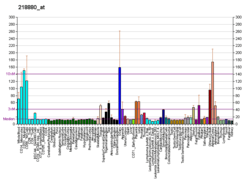FOSL2
Fos-related antigen 2 (FRA2) is a protein that in humans is encoded by the FOSL2 gene.[3]
Function
The Fos gene family consists of 4 members: c-Fos, FOSB, FOSL1, and FOSL2. These genes encode leucine zipper proteins that can dimerize with proteins of the JUN family, thereby forming the transcription factor complex AP-1. As such, the FOS proteins have been implicated as regulators of cell proliferation, differentiation, and transformation.[3]
See also
References
Further reading
- Matsui M, Tokuhara M, Konuma Y, et al. (1990). "Isolation of human fos-related genes and their expression during monocyte-macrophage differentiation.". Oncogene. 5 (3): 249–55. PMID 2107490.
- Molven A, Houge G, Berger R (1997). "Chromosomal assignment of the human gene encoding the Fos-related antigen-2 (FRA2) to chromosome 2p22-p23.". Genomics. 38 (1): 72–5. PMID 8954781. doi:10.1006/geno.1996.0593.
- Outinen PA, Sood SK, Pfeifer SI, et al. (1999). "Homocysteine-induced endoplasmic reticulum stress and growth arrest leads to specific changes in gene expression in human vascular endothelial cells.". Blood. 94 (3): 959–67. PMID 10419887.
- Miyamoto NG, Medberry PS, Hesselgesser J, et al. (2000). "Interleukin-1beta induction of the chemokine RANTES promoter in the human astrocytoma line CH235 requires both constitutive and inducible transcription factors.". J. Neuroimmunol. 105 (1): 78–90. PMID 10713367. doi:10.1016/S0165-5728(00)00195-8.
- Ng DC, Shafaee S, Lee D, Bikle DD (2000). "Requirement of an AP-1 site in the calcium response region of the involucrin promoter.". J. Biol. Chem. 275 (31): 24080–8. PMID 10816578. doi:10.1074/jbc.M002508200.
- Bamberger AM, Milde-Langosch K, Rössing E, et al. (2001). "Expression pattern of the AP-1 family in endometrial cancer: correlations with cell cycle regulators.". J. Cancer Res. Clin. Oncol. 127 (9): 545–50. PMID 11570575. doi:10.1007/s004320100255.
- Udalova IA, Kwiatkowski D (2001). "Interaction of AP-1 with a cluster of NF-kappa B binding elements in the human TNF promoter region.". Biochem. Biophys. Res. Commun. 289 (1): 25–33. PMID 11708771. doi:10.1006/bbrc.2001.5929.
- Benkoussa M, Brand C, Delmotte MH, et al. (2002). "Retinoic acid receptors inhibit AP1 activation by regulating extracellular signal-regulated kinase and CBP recruitment to an AP1-responsive promoter.". Mol. Cell. Biol. 22 (13): 4522–34. PMC 133906
 . PMID 12052862. doi:10.1128/MCB.22.13.4522-4534.2002.
. PMID 12052862. doi:10.1128/MCB.22.13.4522-4534.2002. - Strausberg RL, Feingold EA, Grouse LH, et al. (2003). "Generation and initial analysis of more than 15,000 full-length human and mouse cDNA sequences.". Proc. Natl. Acad. Sci. U.S.A. 99 (26): 16899–903. PMC 139241
 . PMID 12477932. doi:10.1073/pnas.242603899.
. PMID 12477932. doi:10.1073/pnas.242603899. - Santalucía T, Christmann M, Yacoub MH, Brand NJ (2004). "Hypertrophic agonists induce the binding of c-Fos to an AP-1 site in cardiac myocytes: implications for the expression of GLUT1.". Cardiovasc. Res. 59 (3): 639–48. PMID 14499865. doi:10.1016/S0008-6363(03)00472-3.
- Ota T, Suzuki Y, Nishikawa T, et al. (2004). "Complete sequencing and characterization of 21,243 full-length human cDNAs.". Nat. Genet. 36 (1): 40–5. PMID 14702039. doi:10.1038/ng1285.
- Beausoleil SA, Jedrychowski M, Schwartz D, et al. (2004). "Large-scale characterization of HeLa cell nuclear phosphoproteins.". Proc. Natl. Acad. Sci. U.S.A. 101 (33): 12130–5. PMC 514446
 . PMID 15302935. doi:10.1073/pnas.0404720101.
. PMID 15302935. doi:10.1073/pnas.0404720101. - Gerhard DS, Wagner L, Feingold EA, et al. (2004). "The status, quality, and expansion of the NIH full-length cDNA project: the Mammalian Gene Collection (MGC).". Genome Res. 14 (10B): 2121–7. PMC 528928
 . PMID 15489334. doi:10.1101/gr.2596504.
. PMID 15489334. doi:10.1101/gr.2596504. - Rual JF, Venkatesan K, Hao T, et al. (2005). "Towards a proteome-scale map of the human protein-protein interaction network.". Nature. 437 (7062): 1173–8. PMID 16189514. doi:10.1038/nature04209.
- Olsen JV, Blagoev B, Gnad F, et al. (2006). "Global, in vivo, and site-specific phosphorylation dynamics in signaling networks.". Cell. 127 (3): 635–48. PMID 17081983. doi:10.1016/j.cell.2006.09.026.
External links
- FOSL2 protein, human at the US National Library of Medicine Medical Subject Headings (MeSH)
- FactorBook FOSL2
This article incorporates text from the United States National Library of Medicine, which is in the public domain.
This article is issued from
Wikipedia.
The text is licensed under Creative Commons - Attribution - Sharealike.
Additional terms may apply for the media files.


